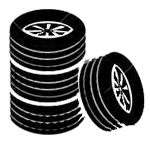What is a crushed BOV?
Owners of highly boosted cars have discovered that the stock 1G BOV tends to begin to open too early. This causes a pressure leak in the intake system that limits boost. The valve tends to leak somewhat at lower boost levels, then opens fully when it's supposed to. This low-level leakage is the problem. The 1G BOV will usually hold pressures to about 22 psi, so this problem usually only appears on cars with upgraded turbochargers.
[2G owners have this problem, times two - the stock 2G BOV can just hold stock boost levels, and tends to start leaking at around 15 psi. 2Gers don't crush their BOV because it's plastic and won't crush. Instead, 2Gers often replace their unit with a stock 1G BOV to eliminate the leakage problem. This works until they too reach the limits of the 1G BOV.]
One DIY solution proposed to fix this problem is to crush the BOV. This means exactly what it says - stick the valve into a vise or clamp and squish it so it doesn't open as early. This is really a cheap & dirty method of increasing the spring force holding the BOV shut, and saves the operator from having to install an expensive aftermarket BOV. This techique can, however, restrict the amount of air that can pass through the BOV when it is wide open, making it a less efficient BOV, and therefore not as good as an aftermarket unit.
Although the technique is simple, individuals should use caution in applying it since various BOVs and crushing techniques are different. The essential technique is to crush the BOV so that it begins to open when 18-20 inHg of vacuum is applied to the reference port. Pristine BOVs will begin to open much earlier than this. Crushing should be done a little at a time until the BOV responds properly. Over-crushing a BOV may result in poor performance.
As with most information available about this modification, this debate remains incomplete. Regardless, owners of stock turbochargers need not concern themselves, as the stock 1G BOV works just fine with stock turbos.
The Last Word: Ray Peters supplied this helpful info on this subject:
"My submission concerns the theory of crushing the BOV. My studies of this concluded that crushing it only solves the open at idle problem and has nothing to do with pressure it will hold. In fact the boost pressure HOLDS the BOV closed plus the spring tension. IMO it is impossible for the valve to leak with all that force on it.
Now the other case, idle and closed throttle operation of the valve. The pressure difference between the intake manifold and the upper intercooler pipe determines when the valve is open. So at idle and when there is more than 15 Inches Hg pressure difference across the throttle plate, the valve begins to open. Crushing the valve slightly increases the spring pressure and raises this difference to just over 20 IN Hg. However the down side is it limits flow because the valve cannot travel fully anymore, and increases the pressure spike against the turbo.
I believe this was done as a workaround so one could dump to atmosphere while using a suck through air measurement device (stock airflow meter or equiv). I tested extensively on both a 1G and a 2G and found this information to be true and correct."
Basically, stop being so cheap - buy a real BOV. [Thanks, Ray!]
QA #31
Last Updated:
2016-05-31 02:48







